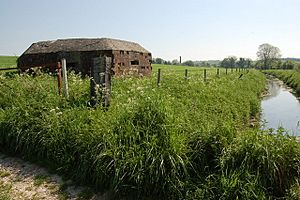GHQ Line facts for kids

The GHQ Line (which stands for General Headquarters Line) was a very important defence line built in the United Kingdom during World War II. Its main purpose was to help stop a possible invasion by Nazi Germany.
After many British soldiers had to leave most of their equipment in France during the Dunkirk evacuation, the country needed a new plan to protect itself. So, leaders decided to build many strong defence lines all over Britain. These lines were like barriers designed to slow down any invading German forces. This would give the British Army time to get ready and fight back. More than 50 such lines were built across the country.
Contents
What Was the GHQ Line?
The GHQ Line was the longest and most important of these defence lines, after the ones right on the coast. It was planned to protect big cities like London and the important industrial areas of Great Britain. Many people saw it as the last line of defence if an invasion happened.
Where Did the GHQ Line Go?
The GHQ Line was made up of different sections, often named after colours.
The Green Section
One part, called the "green" section, started near Highbridge in Somerset. It followed the River Brue and went across the Mendips hills near Wells. Then it followed a railway line into the Wellow valley.
Connecting Lines
This "green" section then connected to the "blue" line, which followed the Kennet and Avon Canal all the way to Reading. The "green" line also continued from Bradford-on-Avon along a river to Malmesbury. There, it met the "red" line, which went to Abingdon and followed the Thames river to Pangbourne. This "red" line then rejoined the "blue" line at Theale.
Protecting Key Areas
The "green" line kept going to Avening and then down a valley to Framilode. This part was very important for protecting big areas like Bristol, Avonmouth, and Sharpness. There was also a plan for an eastern line to run inland from the coast, from Essex all the way to Edinburgh, but this part was never finished. London itself had its own set of defence rings around it, called the Outer London Defence Ring.
Pillboxes Along the Line
In the Essex part of the GHQ Line, between Great Chesterford and Canvey Island, there were about 400 concrete structures called pillboxes. These were small, strong bunkers where soldiers could hide and fire at enemies. They were part of the wider British hardened field defences of World War II.
Even today, in 2023, more than 100 of these pillboxes still exist in this area. About 40 of them are very easy to see, especially along the A130 road between Rettendon Turnpike and Howe Green. Many more can still be found north of Chelmsford, along the Chelmer Valley, and towards Great Dunmow. These old pillboxes are a reminder of the huge effort made to defend Britain during the war.
See also
- British anti-invasion preparations of World War II
- British hardened field defences of World War II
- British military history of World War II
- Coquet Stop Line
- Taunton Stop Line
- Tyne Stop Line
Similar Defences in Other Countries
- Alpine Wall
- Maginot Line
- Siegfried Line

